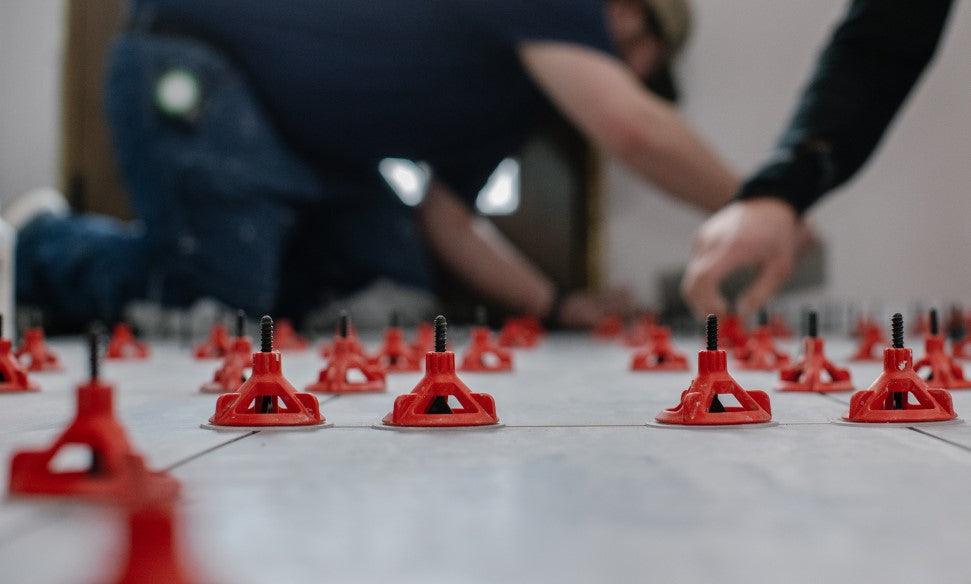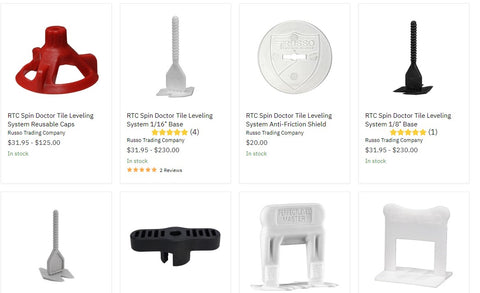
Harnessing the Power of Tile Leveling Systems: Your Complete Guide
Preventing Lippage with the Right Tile Leveling System
Despite the availability of tile leveling clips and anti-tile lippage systems for over a decade, many tilers and home remodelers have yet to utilize these beneficial tools. While using these tile leveling systems is far from rocket science, there's a learning curve to it. This blog aims to provide some fundamental guidelines on using tile leveling systems.
While every kit will have its unique instructions, the underlying principles remain consistent - it's merely the coupling mechanism of the components that may vary. For this reason, always take time to read the instructions provided or watch how to videos by the manufacturer to prevent frustration when you're already knee-deep in your tiling project.
Pro Tip: Don't forget to use tile spacers alongside your tile leveling system!

Porcelain floor tiles designed to imitate wood are impressively durable, but they are infamously known for their extensive warping lengthwise. Using leveling tools can help to reduce the discrepancy in height between consecutive rows.
What is Tile Lippage?
Tile lippage refers to the variation in height between the edges of adjacent tiles. This unevenness creates a scenario where one tile edge is higher than its neighboring tile, leading to a non-uniform surface. The issue of tile lippage is not just aesthetic; it can pose several significant challenges in tiling projects:
-
Tripping Hazard: Tile lippage can lead to an uneven surface, creating tripping hazards, especially in high-traffic areas.
-
Unsightly Appearance: A tiled surface with noticeable lippage looks unprofessional and can detract from the overall appearance of the space.
-
Difficulty in Cleaning: Uneven surfaces are harder to clean as dirt and grime can accumulate in the lower areas adjacent to the higher edges.
-
Increased Wear and Tear: Tiles with lippage are more prone to chipping and cracking, especially along the edges that protrude more.
-
Uneven Wear: Flooring with lippage will experience uneven wear over time, as higher edges bear more foot traffic and impact.
Using a high-quality tile leveling system is an effective way to address and prevent tile lippage. These systems are designed to hold the tiles in place and ensure an even level between them during installation. The Spin Doctor system, in particular, is known for its ease of use and effectiveness. It consists of caps and spacers that work together to maintain a uniform level across the tile surface. The system allows for the adjustment of tile heights, aligning them perfectly to prevent lippage. This not only enhances the aesthetic appeal of the tiling but also ensures a safe, even, and long-lasting surface. By investing in a reliable tile leveling system like Spin Doctor, professionals and DIY enthusiasts can achieve smoother, more professional-looking tiling results with minimal effort.
Preparation is Key
Preparation is a critical best practice in tiling, especially when using a tile leveling system. Quality preparation work is essential for achieving a flawless finish and ensuring the longevity of the tile installation. Let's delve into why this preparation, involving Self-Leveling Underlayment (SLU), backer-board, or a mud bed, is crucial:
-
Foundation for Leveling Systems: Tile leveling systems are designed to minimize lippage between tiles, but they cannot correct significant underlying irregularities. A properly prepared surface is essential for these systems to work effectively. If the base is not level or has major undulations, the leveling system will not be able to compensate for these flaws adequately.
-
Ensuring Tile Adherence: Proper preparation using SLU, backer-board, or a mud bed helps create a flat and stable substrate. This flat surface is vital for the thinset or mortar to adhere the tiles effectively. An uneven substrate can lead to poor tile adhesion, increasing the risk of tiles loosening over time.
-
Preventing Structural Issues: If a tile leveling system were to pull tiles significantly above the substrate to level them, it would create voids underneath the tiles. These hollow spaces mean less mortar is in contact with the tile, compromising the tile's stability and strength. Over time, this can lead to cracking, chipping, or even tiles coming loose.
-
Avoiding Irregularities in Walls and Floors: In cases where walls or floors are significantly out of plumb, preparation work may involve fixing these irregularities with mud or adjusting the backing board. This step ensures that the surface is as level as possible before tile installation begins, providing a better base for the tile leveling system to do its job.
-
Longevity and Durability: A well-prepared surface contributes to the overall durability of the tile installation. It ensures that the tiles are laid on a solid foundation, reducing the likelihood of future problems such as cracking or lifting tiles.
-
Quality Finish: The final appearance of the tiled surface heavily depends on the initial preparation. A well-prepared base allows for a smoother finish, with tiles evenly aligned and minimal lippage, contributing to a more professional and aesthetically pleasing result.
In conclusion, while tile leveling systems are invaluable for achieving a level tile surface, their effectiveness is contingent on the quality of the preparation work. Investing time and effort in properly preparing the surface with SLU, backer-board, or a mud bed ensures that the tile installation will be both visually appealing and structurally sound for years to come.
Managing Lippage: How a Tile Leveling System Can Help
Sometimes, even if the subfloor is even, you can still get lippage due to irregularities in the quality of the tile material. That's where a tile leveling system can come to help. A tile leveling system interlocks the tiles, ensuring that the surface remains smooth and flat while the thinset dries.
This minimizes the possibility of lippage and can also reduce settling from shrinkage. In addition to preventing lippage, a tile leveling system can also reduce the time of installation by almost eliminating the need to lift some of the tiles to add more thinset.
A complete tile leveling system consists of two main components: clips/posts and caps/wedges some systems require a tool to install the components. These elements work together to prevent the movement of tiles when the compound is setting in and to improve the flatness of the surface.
The tile clips/posts guarantee reducing and may eliminate lippage completely. Due to their reduced thickness, the clips/posts can reduce warpage to 1/16 in., which is the allowable lippage for grout joints.
Wedges interact with the face of the tile and as the wedge is pushed further into the clip, it exerts pressure on the tile, pulling it down and aligning it with the surrounding tiles. This helps to ensure that the surface of the tiles is flat and even, minimizing lippage.
The circular base of the tile caps ensures that the pressure is distributed evenly over the surface of the tile. Because the pressure is applied vertically, you don't have to constantly check the variations in height between the tiles.
The role of the tool is to provide the necessary pressure to the tile caps, making it easier for you to obtain a perfect leveling of the surface. The pliers can be used both horizontally (on the floor) and vertically (on the wall.)
If you don't own a tile leveling system and you're just now considering buying one, make sure that the pliers have an ergonomic design. The bi-material handles are lightweight and safe, but they're also sturdy enough to withstand years of constant use.

The Spin Doctor Tile Leveling System using a cap and threaded post to apply downward pressure on the tile to achieve a lippage free tile installation.With the protective base installed it ensures you protect the tile from debris scratching the surface.
The Steps to Using a Tile Leveling System
-
Spread Thinset: Apply thinset to your surface, ensuring your trowel lines only go in one direction. Then, place your tile as usual.
-
Insert Tile Leveling Clip/Post: Slide a clip/base under the tile until it sits flush. Use four clips/posts per tile (more maybe needed depending on the size) to ensure all corners are level with adjacent tiles. Position the clips/posts near the edges or centers of the tile. For larger tiles, you can use up to six tile leveling system clips.
-
Introduce the Next Tile: Lay another tile next to the one with the clip. Now, you can slide a wedge into the clips or screw the cap onto the posts. The idea is that your wedge/cap and base pushes down any high edges, creating a flat surface across the tiles.
-
Remove the Clips/Posts: Once the thinset has cured overnight, you can use a mallet to knock the disposable clips/posts away, thus creating a clean grout joint. You can store the wedges/caps for future use.
Pro Tip: Remember, cleanliness is key. Clear any excess mortar/thinset from the grout joint before it dries. This way, removing the clips/posts will be more manageable, and your grouting task will be easier.

The Levtec Tile Leveling System using a wedge and clip to push the higher edge down to meet the lower edge.
Power of Tile Leveling Systems
The real challenge of tiling lies in achieving perfectly level tiles. Large format tiles, plank tiles, and tiles with straight edges can be especially tricky, often leading to visible lippage, even with meticulous installation.
Here's where tile leveling systems come to the rescue. These systems help even out the smallest of imperfections and maintain uniformity across tiles. And the best part? They hold the tiles in place, preventing slumping as the thinset dries. This significantly reduces installation time and guarantees a flawless, lippage-free finish - every tiler's dream come true.
So, for your next tiling project, consider investing in a tile leveling system. Prepare your surface as you normally would, then let the system here do the hard work. You might be amazed at how much easier it makes the entire tiling process and how professional the final results appear.
If you're a DIY enthusiast, a tile leveling system can level up your home improvement game, allowing you to achieve professional results without having to hire a professional. They're relatively inexpensive, especially when considering the cost of redoing an imperfect tile job.
Remember, patience is the key to a successful tiling project. Ensure to spend ample time preparing the surface and setting up the tile leveling system. Once your tiles are laid and the thinset is cured, you will have a beautifully leveled tiled surface.
To sum it up, tile leveling systems have revolutionized the tiling industry. They make it easier to achieve a professional-looking finish, regardless of the tile size or layout. And they offer a practical solution to common tiling challenges, particularly lippage. Although tile leveling systems aren't magic tools that correct all tiling errors, with proper preparation and use, they can significantly improve the quality of your tile installation.
The Levtec Tile leveling System is a durable wedge and clip solution to eliminate lippage.
Limitations of Tile Leveling Systems
While tile leveling systems are an indispensable tool in any tiler's arsenal, they are not a cure-all. Even the best tile leveling system won't perfectly level an uneven and crooked floor - they can only correct minor lippage, ensuring tiles are flush and stay in plane as the mortar sets.
Shop Tile Leveling Systems 
FAQs
- What is tile lippage?
Tile lippage is the vertical displacement between the edges of two adjoining tiles. It occurs when the tiles are set at different levels.
- Why is preventing tile lippage important?
Preventing tile lippage is important because it can lead to numerous problems, including damaged tiles and safety hazards.
- How do I level the floor for tile?
To level the floor for tile, you need to find dips and peaks, determine the depth of the dip, remove any dirt and debris, mix mortar, fill the dips, grind peaks, and do a final filling.
- What is a tile leveling system?
A tile leveling system interlocks the tiles, ensuring that the surface remains smooth and flat while the thinset dries. This minimizes the possibility of lippage and can also reduce or even eliminate settling from shrinkage.
- What factors should I consider when choosing a tile leveling system?
When choosing a tile leveling system, you should consider factors such as tile size, thickness, material, price, and ease of use. By considering these factors, you can choose the right tile leveling system for your project and ensure that your tiles are set at the same level.
- Can I install tiles without a tile leveling system?
While it is possible to install tiles without a tile leveling system, using one can ensure that your tiles are set at the same level and prevent tile lippage. It can also reduce the time of installation and improve the overall quality of the installation.
- How do I know if I have tile lippage?
You can check for tile lippage by running your hand over the surface of the tiles. If you feel any edges sticking out, it could be a sign of tile lippage. You can also use a straight edge to check for any unevenness between the tiles.
- Can I use a tile leveling system on walls?
Yes, a tile leveling system can be used on walls as well as floors. The pliers can be used vertically to apply pressure to the tile caps and level the tiles on the wall.
- What should I do if I notice tile lippage after installation?
If you notice tile lippage after installation, you should contact your tile installer or contractor to come and inspect the installation. They can determine the cause of the lippage and take steps to fix it, such as replacing the affected tiles or using a tile leveling system for future installations.
- Can I reuse a tile leveling system?
Most tile leveling systems are designed for single-use and some components cannot be reused. However, some systems may allow for reuse of certain components, such as the caps or wedges. Be sure to check the manufacturer's instructions for specific information on reuse.
In conclusion, choosing the right tile leveling system is crucial to preventing tile lippage and ensuring a smooth and even tile installation. By leveling the floor for tile and using a tile leveling system, you can prevent tripping hazards, damaged tiles, and other issues that can compromise the integrity of your project. Consider factors such as tile size, thickness, material, price, and ease of use when choosing a tile leveling system, and always follow proper installation techniques to achieve the best results.

Leave a comment